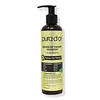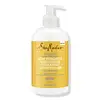What's inside
What's inside
 Key Ingredients
Key Ingredients

 Benefits
Benefits

 Concerns
Concerns

 Ingredients Side-by-side
Ingredients Side-by-side

Aloe Barbadensis Leaf Juice
Skin ConditioningCocamidopropyl Hydroxysultaine
CleansingPolyquaternium-71
HumectantPolyquaternium-73
Sodium Hydroxide
BufferingSodium Cocoyl Glutamate
CleansingLactobacillus Ferment
Skin ConditioningSalix Alba Bark Extract
AstringentMelaleuca Alternifolia Leaf Oil
AntioxidantArgania Spinosa Kernel Oil
EmollientNigella Sativa Seed Oil
EmollientUrtica Dioica Leaf Extract
Skin ConditioningGrateloupia Elliptica Extract
Skin ConditioningBiotin
AntiseborrhoeicSerenoa Serrulata Fruit Extract
Skin ConditioningCedrus Atlantica Bark Oil
MaskingRosmarinus Officinalis Leaf Oil
MaskingSalvia Sclarea Oil
MaskingPolygonum Multiflorum Root Extract
Skin ConditioningHibiscus Sabdariffa Flower Extract
Skin ConditioningPrunus Africana Bark Extract
Skin ConditioningCucurbita Pepo Seed Oil
EmollientCamellia Sinensis Leaf Extract
AntimicrobialZinc Pyrithione
AntiseborrhoeicSoy Isoflavones
Skin ConditioningBeta-Sitosterol
Emulsion StabilisingEmblica Officinalis Fruit
Skin ConditioningCitrus Limon Peel Oil
MaskingCitrus Grandis Seed Extract
AstringentCymbopogon Flexuosus Oil
MaskingRicinus Communis Seed Oil
MaskingNiacin
SmoothingTocopherol
AntioxidantSorbitan Oleate Decylglucoside Crosspolymer
CleansingXylityl Sesquicaprylate
AntimicrobialCitric Acid
BufferingAloe Barbadensis Leaf Juice, Cocamidopropyl Hydroxysultaine, Polyquaternium-71, Polyquaternium-73, Sodium Hydroxide, Sodium Cocoyl Glutamate, Lactobacillus Ferment, Salix Alba Bark Extract, Melaleuca Alternifolia Leaf Oil, Argania Spinosa Kernel Oil, Nigella Sativa Seed Oil, Urtica Dioica Leaf Extract, Grateloupia Elliptica Extract, Biotin, Serenoa Serrulata Fruit Extract, Cedrus Atlantica Bark Oil, Rosmarinus Officinalis Leaf Oil, Salvia Sclarea Oil, Polygonum Multiflorum Root Extract, Hibiscus Sabdariffa Flower Extract, Prunus Africana Bark Extract, Cucurbita Pepo Seed Oil, Camellia Sinensis Leaf Extract, Zinc Pyrithione, Soy Isoflavones, Beta-Sitosterol, Emblica Officinalis Fruit, Citrus Limon Peel Oil, Citrus Grandis Seed Extract, Cymbopogon Flexuosus Oil, Ricinus Communis Seed Oil, Niacin, Tocopherol, Sorbitan Oleate Decylglucoside Crosspolymer, Xylityl Sesquicaprylate, Citric Acid
Water
Skin ConditioningCetearyl Alcohol
EmollientGlycerin
HumectantButyrospermum Parkii Butter
Skin ConditioningStearamidopropyl Dimethylamine
EmulsifyingBehentrimonium Chloride
PreservativeVitis Vinifera Seed Oil
EmollientMelaleuca Alternifolia Leaf Oil
AntioxidantHelianthus Annuus Seed Oil
EmollientTocopherol
AntioxidantPanthenol
Skin ConditioningCaprylic/Capric Triglyceride
MaskingMenthol
MaskingGlycine Soja Oil
EmollientSodium Chloride
MaskingHydroxyethylcellulose
Emulsion StabilisingCitric Acid
BufferingPolysorbate 60
EmulsifyingDisodium Phosphate
BufferingSodium Benzoate
MaskingTriethyl Citrate
MaskingCaprylyl Glycol
EmollientBenzoic Acid
MaskingParfum
MaskingWater, Cetearyl Alcohol, Glycerin, Butyrospermum Parkii Butter, Stearamidopropyl Dimethylamine, Behentrimonium Chloride, Vitis Vinifera Seed Oil, Melaleuca Alternifolia Leaf Oil, Helianthus Annuus Seed Oil, Tocopherol, Panthenol, Caprylic/Capric Triglyceride, Menthol, Glycine Soja Oil, Sodium Chloride, Hydroxyethylcellulose, Citric Acid, Polysorbate 60, Disodium Phosphate, Sodium Benzoate, Triethyl Citrate, Caprylyl Glycol, Benzoic Acid, Parfum
 Reviews
Reviews

Ingredients Explained
These ingredients are found in both products.
Ingredients higher up in an ingredient list are typically present in a larger amount.
Citric Acid is an alpha hydroxy acid (AHA) naturally found in citrus fruits like oranges, lemons, and limes.
Like other AHAs, citric acid can exfoliate skin by breaking down the bonds that hold dead skin cells together. This helps reveal smoother and brighter skin underneath.
However, this exfoliating effect only happens at high concentrations (20%) which can be hard to find in cosmetic products.
Due to this, citric acid is usually included in small amounts as a pH adjuster. This helps keep products slightly more acidic and compatible with skin's natural pH.
In skincare formulas, citric acid can:
While it can provide some skin benefits, research shows lactic acid and glycolic acid are generally more effective and less irritating exfoliants.
Most citric acid used in skincare today is made by fermenting sugars (usually from molasses). This synthetic version is identical to the natural citrus form but easier to stabilize and use in formulations.
Read more about some other popular AHA's here:
Learn more about Citric AcidThis tea tree oil comes from the leaves of the Tea Tree plant. Tea tree oil has antioxidant, anti-inflammatory, and antimicrobial properties.
According to the book Journal of Profiles of Drug Substances, tea tree helps in reducing acne-causing bacteria such as Propionibacterium acnes. This is due to the Terpinen components of tea tree oil.
Tea tree may cause sensitivity and irritation for some people. This oil naturally contains fragrance such as linalool and limonene.
However, research shows irritation usually occurs when using pure tea tree oil and not in cosmetic products.
Tea tree oil was found to help relieve the symptoms of psoriasis in one study.
Tea tree oil is toxic when ingested. Another study showed it to caused damage to the nervous system of dogs and cats when applied to their skin or given orally.
Learn more about Melaleuca Alternifolia Leaf OilTocopherol (also known as Vitamin E) is a common antioxidant used to help protect the skin from free-radicals and strengthen the skin barrier. It's also fat soluble - this means our skin is great at absorbing it.
Vitamin E also helps keep your natural skin lipids healthy. Your lipid skin barrier naturally consists of lipids, ceramides, and fatty acids. Vitamin E offers extra protection for your skin’s lipid barrier, keeping your skin healthy and nourished.
Another benefit is a bit of UV protection. Vitamin E helps reduce the damage caused by UVB rays. (It should not replace your sunscreen). Combining it with Vitamin C can decrease sunburned cells and hyperpigmentation after UV exposure.
You might have noticed Vitamin E + C often paired together. This is because it is great at stabilizing Vitamin C. Using the two together helps increase the effectiveness of both ingredients.
There are often claims that Vitamin E can reduce/prevent scarring, but these claims haven't been confirmed by scientific research.
Learn more about Tocopherol